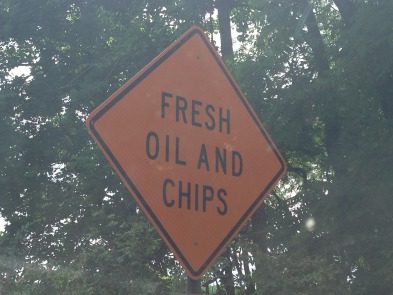Editor’s Note: This story was originally published on Guilford Patch on August 21, 2013. It was written in response to complaints from people in town about chip seal, a conversation that started on the Guilford Patch Facebook page and was later moved over to the Guilford Patch site.

Guilford Town Engineer and Facilities Manager Jim Portley said the roads that have been chip sealed will be swept soon, removing excess stone.
Guilford Town Engineer and Facilities Manager Jim Portley knows that the town’s recent efforts to repair and maintain roads using chip seal is not entirely popular with some residents who are worried that the roads are now less suitable for walking, bike riding, and other neighborhood activities.
But he’s asking for a little patience. He says that the work is still underway and that the town will begin sweeping up excess stone on August 26th. After that, he said, the roads will be done.
“We started the work on August 12th and we should be finished by Friday,” he said earlier this week. “We will start sweeping up the excess stone on the 26th and that should help. After that, we’ll be keeping an eye on it to make sure it is OK. We don’t want to waste the stone and we don’t want people to be unhappy. After we sweep it up, walking and cycling should not be a problem.”
Town residents, on the Guilford Patch Facebook page and on Guilford Patch, have expressed concern that the chip and seal method of repaving roads makes them treacherous for bikers and skateboards, that it leaves walkers with oily shoes, and that the excess stone, when cars drive by, goes airborne, making it feel like they are being pelted with “shrapnel” if they are out in their yards.
Portley says that if residents continue to have concerns about their roads after they have been swept, that they should contact him at 203-453-8037 or portleyj@ci.guilford.ct.us.
The chip seal method of repairing roads is “a little more coarse” than laying down asphalt, Portley said, but he also said it is much more cost effective than laying down asphalt.
“Chip sealing is by far the most efficient and economical way to preserve the integrity of the pavement,” he said. “The oil seals the cracks. And it tends to rejuvenate the pavement. The stone that is put on top will provide better traction in the winter time.”
The alternative methods of preserving the roads are much more expensive, he said. “I don’t have the numbers right in front of me, but putting another layer of asphalt over, it can be five or six times the cost per square yard. It is a very, very expensive proposition versus chip sealing.”
He said the town has about 200 miles of road that it needs to maintain. “With chip sealing, we can take care of them every seven or eight years, depending on funding. If we just did overlay, we’d not only have to increase funding dramatically, it might be 40 or 50 years before we got to all of them. By that time, we might as well have nothing. They would turn back to dirt roads.”
The town has such a large inventory of roads it must maintain that the only effective way of doing it is chip seal, he said.
Still, he said, he’s sorry it’s causing some town residents distress. He said he knows that people like to skateboard, ride bikes, walk and engage in neighborhood activities like playing basketball and doing sidewalk chalk on roads. In other words, he understands that many neighborhood roads serve as the link between neighbors, who travel them and use them in a wide variety of ways. He knows that cul de sacs, in particular, often serve as a “natural playground.”
“If problems continue, they should contact me. If we can address anyone’s concerns, we will. We’re not going to tell them, ‘too bad.’ If we have to go back and re-sweep, we will,” he said. “We want to serve the public. If there’s an issue that needs to be addressed, we’ll try to address it.”
How to gather information, assess it, and present it in a way readers will understand and appreciate